PIB Headquarters
Artisans of a Nation
Posted On:
20 NOV 2025 11:24AM by PIB Delhi
The India International Trade Fair: A Living Showcase of ‘Ek Bharat Shreshtha Bharat’

The India International Trade Fair (IITF), held at Bharat Mandapam, stands as one of India’s largest and most culturally immersive exhibitions. With its 44-year legacy and this year’s theme of ‘Ek Bharat Shreshtha Bharat’, the fair brings together partner states, focus states, ministries, global participants, MSMEs, artisans and start-ups under one roof, reflecting India’s unity in diversity and its economic confidence. The fair’s expansive layout — featuring multi-product halls, state pavilions, international delegations, and a vibrant cultural calendar — creates a dynamic ecosystem where heritage, innovation and enterprise converge.
Witnessing India in its Full Cultural Spectrum
From the perspective of a visitor, the India International Trade Fair unfolds like a panoramic journey across India’s cultural and artisanal heritage. Moving through the halls, one encounters the country’s linguistic, artistic and regional diversity materialise in colour, texture, and craft.
Each pavilion carries the distinct identity of its state — from handlooms and tribal art in Jharkhand, to the intricate metalwork displayed by Uttar Pradesh, to the vibrant block-prints of Rajasthan. Mirror-work shimmers under exhibition lights, terracotta wares line the aisles, and tribal jewellery, bamboo craft, jute work, and hand-embroidered textiles showcase skills preserved over generations. These handicrafts, highlighted prominently within IITF’s multi-product profile, mesmerise visitors with their kaleidoscopic repertoire of motifs,
techniques, and mediums.
Across the fair, the theme of Ek Bharat Shreshtha Bharat echoes powerfully. State Day cultural performances, folk music, classical arts, and workshops create an immersive environment where visitors can witness India’s unity in diversity expressed through craft, culture and creativity.
A Platform That Sustains Craft, Community and Commerce
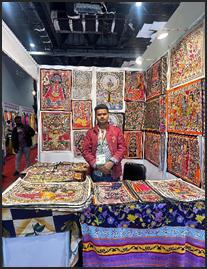
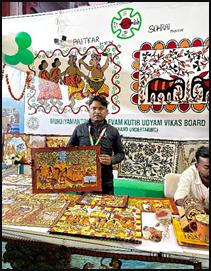
From the perspective of an exhibitor, the India International Trade Fair is not merely an annual showcase — it is a space where years of practice, family traditions and community identities stand before the world. Behind every stall is a story: the early morning loom work, the carefully packed cartons that travel miles, the hope that a new buyer might help sustain an art form for another generation.
Across the halls, a wide range of craft communities echoed similar experiences. Paitkar artists from Jharkhand spoke about how the fair helps revive one of India’s oldest scroll-painting traditions, allowing them to narrate stories through their detailed linework. Madhubani painters from Bihar shared that IITF enables direct engagement with visitors who appreciate the precision and symbolism embedded in hand-painted work.
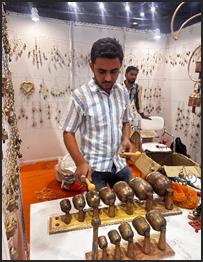
From Kutch, traditional cowbell makers reflected on how their craft has evolved with time. Originally created only as functional bells for cattle, the craft today extends to musical instruments, wind chimes and decorative hangings that retain the same hand-tuned sound.
They added that IITF gives them the rare access to interact with international exhibitors and visitors.
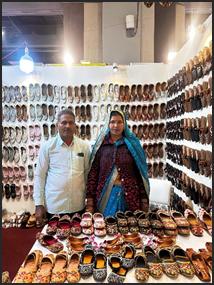
Similarly, jutti artisans from Rajasthan highlighted that the fair sustains their labour-intensive leathercraft, especially at a time when machine-made footwear dominates markets. Numerous handloom clusters from across India noted that IITF remains one of the few platforms where diverse regional weaving traditions — from tribal weaves to heritage silks — are showcased to a wide and appreciative audience.

For many exhibitors, participation in the fair is directly linked to livelihood security. The event connects them to buyers they might otherwise never reach — exporters, institutional purchasers and families seeking authentic handmade work. The mix of business days and general public days helps artisans negotiate orders, expand their networks and interact with audiences who value craftsmanship.
Above all, IITF gives artisans a sense of recognition. It allows them to speak about the processes, materials and histories behind their work, reaffirming their place in India’s cultural and creative landscape. For communities that have preserved these crafts for generations, the fair stands as a reminder that their skills remain relevant, respected and celebrated.

Dr. G. Dasaradha Chari– Traditional Wood Carving,
Belonging to a family that has practised wood carving for centuries, Dr. G. Dasaradha represents a craft deeply rooted in temple tradition. Today, he and the artisans in his region create both traditional panels and modern utility items using red sandalwood, white sandalwood, rosewood and teak.
“Our technique has been passed down through generations. Even when we make contemporary items, the skill remains the same,” he notes.
For more than 25 years, he has been showcasing his work at IITF. “In an age of online markets, IITF is a genuine platform. People can see and feel the workmanship, and understand the effort behind each piece,” he says.
|
Debaki Parida – Dhokra Art, Odisha
For Debaki, Dhokra is a living tradition that defines the cultural identity of her tribal community. She works with women from her village to create brass figurines, ornaments and motifs inspired by everyday tribal life.
“Every design reflects where we come from. When people see our work, they understand our culture,” she says. Participating in IITF gives her a platform to directly interact with visitors and narrate the story behind each piece.
“Here, I stand beside my products and explain how we make them. IITF gives small artisans like us the confidence that our heritage is valued,” she adds.
|
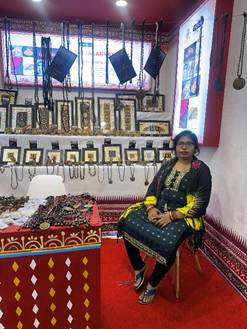
Voices from the Fair
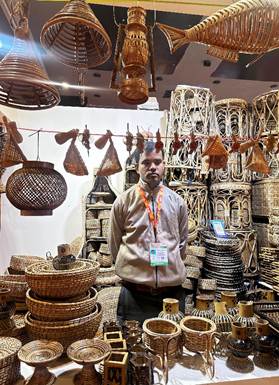
Dhiraj – Cane and Bamboo Craft, Assam
Continuing his family’s legacy, Dhiraj works with a team of artisans to produce cane and bamboo products that reflect Assam’s long-standing craft traditions. “In our village, many families depend on this work. Every item supports someone’s livelihood,” he says.
Despite online sales, he sees IITF as an unmatched opportunity. “People come here, hold the product and see the skill involved. That recognition is important for us artisans,” he explains.
|
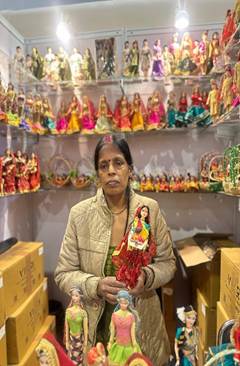
Madhuri Singh – Traditional Clay and Jute Dolls, Bihar
A former schoolteacher, Madhuri began creating traditional clay and jute dolls during the pandemic. Her dolls portray Indian customs, festivals and attire, combining hand-sculpted clay bodies with colourful jute garments.
“I wanted to make dolls that look like our own people and our own traditions,” she explains.
Her work has inspired many young girls and women in her community to learn the craft.
“If they learn this skill, they can support themselves. That is why I teach them,” she adds.
At IITF, she feels her work receives an audience that understands its cultural relevance.
|
The Larger Significance of IITF in India’s Cultural and Economic Story
At the India International Trade Fair, the idea of Ek Bharat Shreshtha Bharat comes alive not in grand declarations, but in the quiet harmony of shared craftsmanship. Here, the colours of Madhubani meet the shine of Dhokra; the rhythm of Kutch’s cowbells blends with the softness of Assam’s cane; and the stories etched in Tirupati wood rest beside the clay traditions of Bihar.
In these stalls and corridors, India’s diversity does not stand apart — it stands together. Every artisan brings a piece of their soil, their memory, their lineage, and places it on a platform where it becomes part of a larger national tapestry. Visitors pause, listen, learn and carry these stories with them, becoming threads in that tapestry themselves.
As the fairgrounds settle each evening, what remains is the reminder that India’s strength lies in this effortless convergence — many cultures, many languages, many hands, creating one shared identity. IITF captures this unity with a quiet grace, proving that when the country’s traditions stand side by side, India is not just diverse; it is beautifully, powerfully whole.
Artisans of a Nation
*****
RK
(Release ID: 2191954)
Visitor Counter : 554